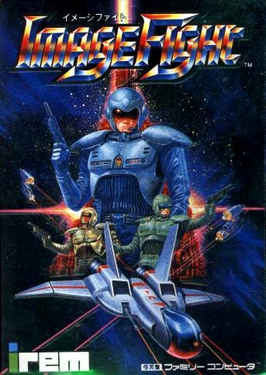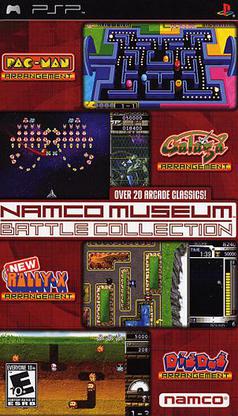
R-Type is a horizontally scrolling shooter arcade video game developed and released by Irem in 1987 and the first game in the R-Type series. The player controls a star ship, the R-9 "Arrowhead", in its efforts to destroy the Bydo, a powerful alien race bent on wiping out all of mankind. The R-9 can acquire a glowing orbicular device called a "Force", protecting it from enemy fire and providing additional firepower. The arcade version was distributed by Nintendo in North America; it is the last arcade title Nintendo distributed.

Radiant Silvergun is a shoot 'em up video game developed and published by Treasure. It was originally released in Japanese arcades in 1998 and subsequently ported to the Sega Saturn later that year. The story follows a team of fighter pilots in the far future who are battling waves of enemies summoned by a mysterious crystal dug up from the Earth. The player hosts an arsenal of six different types of shots to choose from, and a sword to destroy nearby targets. The stages are tightly designed to present players with scenarios that can be approached differently with the various weapon types.

Irem Software Engineering is a Japanese video game developer and publisher, and formerly a developer and manufacturer of arcade games as well. The company has its headquarters in Chiyoda, Tokyo.

Metal Slug is a 1996 run and gun arcade video game originally developed by Nazca Corporation and released by SNK for the Neo Geo MVS. It is the first installment in the eponymous series. Set in 2028, players assume the role of Peregrine Falcon Strike Force soldiers Marco Rossi and Tarma Roving on a fight against the Rebel Army led by Donald Morden and overthrow his coup d'état to prevent a New World Order.

Lode Runner is a 2D puzzle-platform game, developed by Doug Smith and published by Broderbund in 1983. Its gameplay mechanics are similar to Space Panic from 1980. The player controls a character who must collect all the gold pieces in a level and get to the end while being chased by a number of enemies. It is one of the first games to include a level editor.

Xevious is a vertically scrolling shooter arcade video game developed and published by Namco in 1982. It was released in Japan by Namco and in North America by Atari, Inc. Controlling the Solvalou starship, the player attacks Xevious forces before they destroy all of mankind. The Solvalou has two weapons at its disposal: a zapper to destroy flying craft, and a blaster to bomb ground installations and enemies. It runs on the Namco Galaga arcade system.

Moon Patrol is a 1982 arcade video game developed and released by Irem. It was licensed to Williams for distribution in North America. The player controls a Moon buggy which can jump over and shoot obstacles on a horizontally scrolling landscape as well as shoot aerial attackers. Designed by Takashi Nishiyama, Moon Patrol is often credited with the introduction of full parallax scrolling in side-scrolling games. Cabinet art for the Williams version was done by Larry Day. Most of the home ports were from Atari, Inc., sometimes under the Atarisoft label.

Kung-Fu Master, known as Spartan X in Japan, is a 1984 beat 'em up game developed and published by Irem for arcades. It was distributed by Data East in North America. Designed by Takashi Nishiyama, the game was based on Hong Kong martial arts films. It is a loose adaptation of the Jackie Chan, Sammo Hung and Yuen Biao film Wheels on Meals (1984), called Spartan X in Japan, with the protagonist Thomas named after Jackie Chan's character in the film. The game is also heavily inspired by the Bruce Lee film Game of Death (1972), which was the basis for the game's concept. Nishiyama, who had previously designed the side-scrolling shooter Moon Patrol (1982), combined fighting elements with a shoot 'em up gameplay rhythm. Irem and Data East exported the game to the West without the Spartan X license.

Image Fight is a 1988 vertically scrolling shooter arcade video game developed and published by Irem. It was ported to the Nintendo Entertainment System, PC Engine, Sharp X68000 and FM Towns in 1990. The NES version was the only version that was released in North America. It was followed by Image Fight II: Operation Deepstriker.

R-Type Delta is a shoot 'em up video game developed and published by Irem for the PlayStation. It is the fourth game in the R-Type series and the first to feature 3D graphics. The game received generally positive reviews from critics.

R-Type Final is a horizontal shooter video game by Irem for the PlayStation 2 video game console. It was planned to be the last mainline game in the R-Type series. However, R-Type Tactics was released for the PlayStation Portable in 2007, and the direct sequel R-Type Final 2 was announced on March 30, 2019, and was released on April 29, 2021.

R-Type II is a horizontally scrolling shooter developed and published by Irem. It was released in arcades in 1989. It is the sequel to R-Type, and the second game in the R-Type series.

Namco Museum Battle Collection is a 2005 video game compilation developed by Tose and published by Namco for the PlayStation Portable; the first Namco Museum since the original PlayStation series to be developed in Japan. It includes 21 games - four of these are brand-new "arrangement" remakes of older Namco games, while the rest are emulated ports of Namco arcade games from the 1970s and 1980s. These ports include an options menu that allows the player to modify the in-game settings, such as the screen orientation and number of lives. Players can send one-level demos to a friend's console via the "Game Sharing" option in the main menu.

R-Type Leo is a 1992 horizontal-scrolling shooter arcade game developed by Nanao and published by Irem. It is a spin-off of the R-Type series and the last R-Type entry to be released in arcades. In Leo, players take control of the titular space fighter to travel the man-made mechanical planet Eden and destroy its supercomputer core Major. The game was initially conceived as an original shoot 'em up by Nanao before being retooled into an R-Type project by Irem. The title was met with positive reception from reviewers. It has since been re-released as part of Dotemu's 2010 Irem Arcade Hits compilation.

Namco Classic Collection Vol. 1 is a 1995 arcade game compilation developed and published by Namco. It includes three of the company's most well-known games from the early 1980s — Galaga (1981), Xevious (1983), and Mappy (1983) — alongside brand-new "Arrangement" remakes of these games that have updated gameplay, visuals, and sounds. The arcade originals are also modified slightly to end after a certain number of rounds. Super Xevious (1984) is also playable. It ran on the Namco ND-1 arcade system, being one of the first games to utilize it.

Xevious 3D/G is a 1996 vertically scrolling shooter video game developed and published by Namco for arcades. The eighth entry in the Xevious series, it combines 2D-based gameplay with 3D gouraud-shaded polygon graphics. Players control the Solvalou starship in its mission to destroy a rogue supercomputer named GAMP and the Xevian Forces, using two basic weapon types: an air zapper to destroy air targets, and a blaster bomb to destroy ground targets. The game also features destructive power-ups, new bosses, and two player simultaneous play.

In the Hunt is a 1993 scrolling shooter arcade video game developed and published by Irem. It is the third installment of D.A.S. Tetralogy. Versions for the PlayStation, Sega Saturn, and Microsoft Windows were also released. The player assumes control of the Granvia, a submarine tasked with overthrowing the Dark Anarchy Society before they activate their doomsday device. Gameplay involves shooting enemies, collecting power-up items, and avoiding collision with projectiles. It runs on the Irem M-92 hardware.

Hammerin' Harry, known in Japan as Daiku no Gen-san, is a series of platforming video games developed and published by Irem in 1990. The titles were developed and published for the arcades, Famicom, Game Boy, Super Famicom and Sony PSP platforms. The series is centered around the titular Harry, a hammer-wielding carpenter who protects his hometown of Beranme from the corrupt construction companies that mean to tear it down.

Nazca Corporation was a Japanese company that developed video games for the Neo Geo games console. The company was formed in 1994 by a group of employees from Irem who were tired of the company's inactivity. In 1996, the company was acquired by SNK.

Arcade's Greatest Hits: The Midway Collection 2 is a compilation of arcade video games either made by, or acquired by Midway Games for the PlayStation and Windows. This game is technically the sequel to Williams Arcade's Greatest Hits, which also had Midway acquired games included, also released on the PlayStation.





















